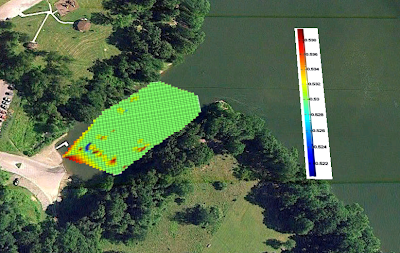On Wednesday the 8th of August the CRW Team headed out to Crooked Creek Lake for some field testing to try out a few new boat designs and features that were added recently.
The sun was beating down by the time the team arrived and we were all eager to get underway with the testing. Initially the team did some basic testing with our GenX boats and were gearing up all 8 boats that we had taken in preparation to try tackle a new record of 8 boats in the water at the same time.
The highlights of the day included the debut of two new boats nicknamed The “Rainbow” and “Camo”, designed by one of our interns for the summer, Ally. These two boats have many experimental features like rounded backs to reduce the chance of getting caught on banks and varying types of keel’s to analyze the affect they would have on the drag as well as hydroplaning. We were pleasantly surprised by the results. The camo boat went especially well, avoiding getting caught on banks and other obstacles. It displayed much better maneuverability while compared to the previous versions.
 |
| Camo |
 |
| Rainbow |
After the successful morning the team attempted to deploy all 8 boats at once with Abhinav at the helm under his umbrella setting autonomy tasks for all the boats.
After being continuously distracted by other boats coming in and out of the water we managed to deploy all the 8 airboats. Some of the boats exhibited unexpected behavior, likely caused by poor GPS signal. This prevented some of them from functioning properly while the team tested the boats fail safe mechanism.
After a few of us dipping our feet in the water and having a nice BBQ lunch, the airboats were back out on the water to test the new obstacle avoidance. This test was highly anticipated as the team had specially built an obstacle to put out in the water. This test was partially successful although we had certain drawbacks due to a large amount of false positives identified, which caused the boats to unnecessarily change course.
The team then began sampling using one of the GenX boats. The boat was equipped a temperature sensor, a specific conductivity sensor and a dissolved oxygen probe. An overlay of the sampling plots obtained from this test is shown below. While there wasn't much spatial change in the specific conductivity, there was significant variation in temperature and dissolved oxygen. The specific conductivity varied from 0.522 dS/m to 0.538 dS/m, while the dissolved oxygen varied from 7.8 mg/L to 8.4 mg/L. The average temperature was 29.9753 °C.
 |
| Map generated from sampling showing the variation in dissolved oxygen in mg/L |
 |
| Map generated from sampling showing the variation in specific conductivity in dS/m |
 |
| Map generated from sampling showing the variation in temperate in °C |
Overall there were many promising results obtained from this field test and everyone headed back to CMU in the late afternoon with smiles on our faces.
Stay tuned for more on the CRW Project!





Drinking water should be tested because there are many micro-organisms like bacteria which are not visible to the naked eye which can cause serious health problems.
ReplyDeleteTurbidity Meter
nice
ReplyDelete